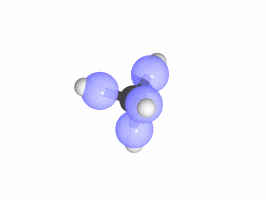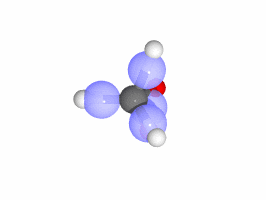Taking again CH4 as the example, the deviations of the nuclei from their equilibrium positions are fairly small, both at low and at high temperatures, and their relative positions are never exchanged. This can be seen from the animation on the left hand side; the overall rotation of the molecule has been eliminated. In addition to the positions of the five nuclei (carbon in grey and protons in white) the electronic structure is also visualized: the four blue clouds are the centers of the so-called localized valence orbitals that host two paired electrons each. Based on this animation it appears that the molecular structure of CH4 can be faithfully described by a tetrahedron—a picture that is found in every highschool-level textbook—with one bonding electron pair for each carbon-hydrogen chemical bond.
However, the behavior of methane changes dramatically once it gets protonated, that is after the reaction CH4 + H+ → CH5+ has taken place. This is a simple chemical reaction that is observed in various experiments both in the gas phase and in very acidic solutions (using so-called “superacids”). Although easy to make and known for many decades (at least since 1952), it wasn't until the year 1999 that the infrared spectrum of CH5+ could be inferred in Oka's top-level spectroscopy laboratory in Chicago (E. T. White, J. Tang, and T. Oka, Science 284, 135–137 (1999))—having started the search in 1983! Nearly 1000 lines have been resolved in a very narrow spectral range from about 2800 to 3100 cm-1. But despite this incredible amount of information it was not possible to link the spectrum of CH5+ to its structure so that the authors stated on p. 136: “Here we present its spectrum as observed without assignment (or even qualitative understanding).”
How come? The reason for this can be guessed from the animation depicted above on the right hand side. It shows the classical dynamics of an isolated CH5+ molecule under conditions identical to those for CH4. The “structure” of this molecule appears to be not at all rigid, but rather constantly changing. For this reason such molecules are called “fluctuating”, “fuxional”, or “floppy”. But despite these dyamical changes one can still infer structural motifs. For most of the time, a H2 group (highlighted in red) can be identified, which is attached to the apex (i.e. the carbon nucleus) of a remaining CH3 tripod, whose symmetry axis is perpendicular to the, virtual, H2 molecular axis. However, the H2 group is not fixed in space but is observed to constantly “rotate” around the carbon center (despite the fact that the overall rotation has been eliminated)! As a result, the red H atoms are constantly in motion. But closer inspection reveals that it is not a fixed H2 group that rotates; only the labels of its two constituent H-atoms (or, more precisely, protons) change as a function of time. The technical term for this phenomenon is “pseudo-rotation”.
A simple picture would be that CH5+ behaves more like a liquid water droplet (where all atoms constantly change their position, while there is still some “local order” persisting) and not like a corresponding frozen snowflake (where every atom is fixed close to a well-defined position, which it “never” leaves). Another interesting aspect is that CH5+ shows a peculiar form of chemical bonding: there are five protons but only four available valence orbitals! Thus, it is not possible that one electron pair, or one localized orbital, respectively, is located in between the carbon nucleus and each proton like in methane, CH4. Nevertheless, bonding is possible also in protonated methane, CH5+, since the two protons that make up the H2 group “share” one orbital—namely the one that sits in between the sticks that connect the two red protons with the carbon nucleus. Chemists call this type of bonding “three-center two-electron bonding” since two paired electrons bind three nuclei, the simplest example being H3+. More about such “multi-center bonds” can be found in a study on chemical bonding in lithium.
Based on dynamical trajectories of both the nuclei and the centers of the localized orbitals such as the ones shown above it is possible to compute the infrared spectrum of CH5+. This has been done and the theoretical spectrum thus obtained compares very well to the experimental one that became available in a joint theoretical/experimental study that has been published in Science (2005, see below). The experimental data have been obtained with the sophisticated "laser induced reactions" technique used in combination with the Free Electron Laser FELIX in the Netherlands which allowed to cover a em broad spectral range covering about 500 to 3200 cm-1 Most important is the fact that the spectrum can only be explained and thus understood in terms of the scenario outlined above where fluxionality and “three-center two-electron bonding” are crucial ingredients.
However, a severe technical difficulty had to be solved for computing the infrared spectrum of this very peculiar molecule: usually, such spectra are obtained in the so-called “harmonic approximation” which assumes that all nuclei of the molecule always stay close to their equilibrium position. This is a very good approximation for a quasi-rigid molecule like CH4, but it fails for a fluxional species like CH5+. The dynamical trajectories, on the other hand, do contain the anharmonicities and pseudo-rotations so that spectra based on them (more precisely the quantum-correct Fourier transform of the total dipole autocorrelation function) do also embody these crucial effects. Finally, it may be stimulating to know that the short animations depicted above are based on calculations that these days can be done in less than one day on a standard PC! The computation of the infrared spectrum, however, is much more demanding for various reasons.
Further information and details:
- Quantum simulations (Born-Oppenheimer molecular dynamics) and analysis
- Padma Kumar (Ruhr-Universität Bochum)
- Ilka Hegemann (Ruhr-Universität Bochum)
in collaboration with - Dominik Marx (Ruhr-Universität Bochum)
- Scientific visualization
- Eduard Schreiner (Ruhr-Universität Bochum)
- Nikos Doltsinis (Ruhr-Universität Bochum)
- Additional information
- RUB Pressemitteilung
- The first broad-frequency infrared spectrum of CH5+:
O. Asvany, P. Kumar P, B. Redlich, I. Hegemann, S. Schlemmer, and D. Marx,
Understanding the Infrared Spectrum of Bare CH5+,
Science 309, 1219–1222 (2005)
This article has been selected for online publication in Sciencexpress
(“providing rapid electronic publication of selected Science papers based on timeliness and importance of the research”) - Feature article in Chem. & Eng. News (ACS)
- Feature article in Physik Journal (DPG)
- Selected as one of the Chemistry Highlights 2005:
S. Borman, Chem. & Eng. News 83 (51), 15-20 (2005) - Detailed analysis of the dynamics and the IR spectrum:
P. Kumar P. and D. Marx,
Understanding hydrogen scrambling and infrared spectrum of bare CH5+ based on ab initio simulations,
Phys. Chem. Chem. Phys. 8, 573 (2006) - Feature article on CH5+:
D. Marx and M. Parrinello,
CH5+—The Cheshire Cat Smiles,
Science 284, 59 (1999) - Electronic structure analysis:
D. Marx and A. Savin,
Topological Bifurcation Analysis: Electronic Structure of CH5+,
Angew. Chem. Int. Ed. Engl. 36, 2077 (1997) - Expert introduction into the simulation techniques
- Finally visit the magnificent home of ELF: http://www.cpfs.mpg.de/ELF/
- This web page
http://www.theochem.ruhr-uni-bochum.de/go/ch5p.html





